We’re used to flagship handsets costing over £1,000 SIM-free, and Sony has added another to this exclusive group with its Xperia I III. At £1,199 ($1,299.99 in the US), it’s a little more expensive than the Oppo Find X3 Pro 5G and matches the Xiaomi Mi 11 Ultra, both reviewed here in recent months. The Xperia 1 III stands out for its high refresh-rate (120Hz) 4K OLED screen and a lavish feature set built around Qualcomm’s top-end Snapdragon 888 chipset and an excellent rear camera array.
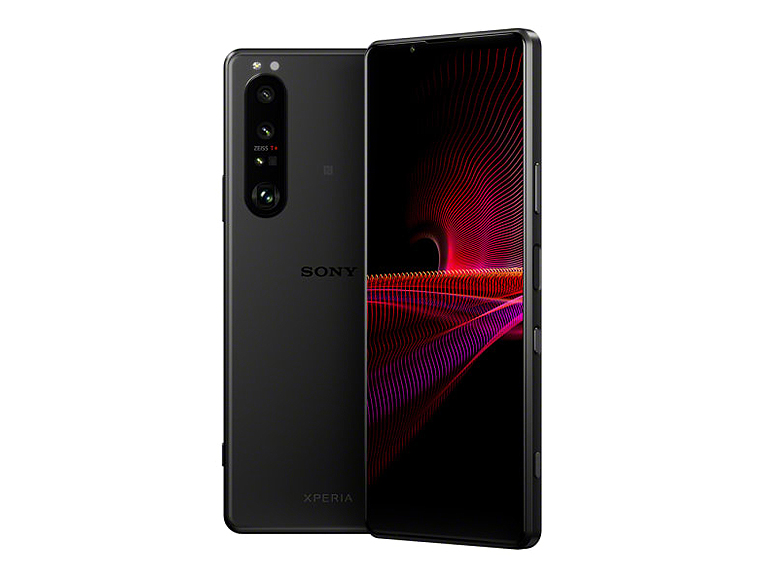
The 6.5-inch Xperia 1 III runs Android 11 on Qualcomm’s top-end Snapdragon 888 5G chipset with 12GB of RAM and 256GB of internal storage (expandable via MicroSD card at the expense of one of the two SIM slots). The screen is a 4K OLED panel with a maximum refresh rate of 120Hz.
Image: Sony
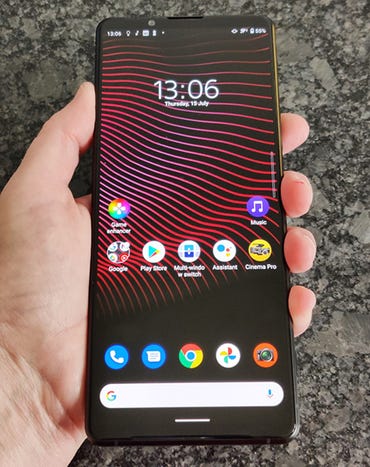
The screen’s 21:9 aspect ratio makes for a tall (165mm) handset.
Image: Sandra Vogel / ZDNet
Sony takes a distinctive approach to handset design, with its Xperia range incorporating a tall (or wide, in landscape mode) 21:9 screen that’s suited to video watching, games playing and photography. The handset’s elongated 165mm by 71mm by 8.2mm chassis can poke out of a pocket, and while I could reach across the screen easily when navigating one-handed in portrait mode, there’s no way I could sweep from top to bottom. When you are working one handed, though, the Xperia 1 III feels nicely balanced and not too heavy at 186g.
In terms of dimensions, there’s almost no difference between Sony 2021 flagship and last year’s Xperia I II — just tiny gains on thickness (8.2mm vs 7.6mm) and weight (186g vs 181.4g). This may have something to do with the incorporation of a larger battery this time around (4500mAh vs 4000mAh).
Design-wise, Sony’s handsets have characteristically squarer corners and a more slab-like appearance than rival phones. The company doesn’t ring the changes every year, as some manufacturers do, and if I had the Xperia 1 II sitting side by side with this year’s model, it would be hard to tell the difference.
The handset’s edges and Gorilla Glass 6 backplate have a matte finish compared to last year’s reflective look. This makes it easier to hold the phone securely, while the back is less prone to capturing finger-marks. The camera lozenge positioning and shape is unchanged, and Sony should perhaps have made design changes here, as the tall, narrow lozenge protrudes significantly. This means the phone has an annoying tendency to bounce around on a table if the upper left or bottom right quadrants of the screen need a tap.
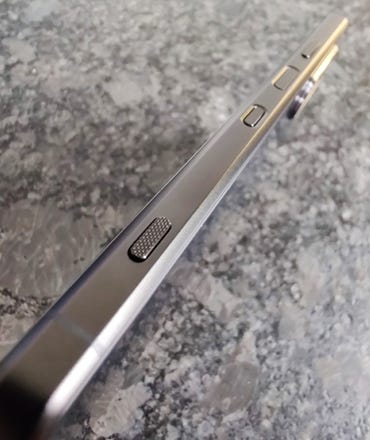
Buttons on the right edge (from top): volume, power, Google Assistant, camera.
Image: Sandra Vogel / ZDNet
The right edge houses a power button incorporating a fingerprint scanner, a small volume rocker and a raised, tactile camera shutter button towards the bottom. This will start up the camera software when pressed, allowing you to capture fleeting photo opportunities. These three buttons were present on last year’s model, but the Xperia 1 III adds a fourth — a Google Assistant shortcut button.
The SIM caddy on the left edge pops out easily without the need for a special tool. The phone accommodates two SIMs or a single SIM and a MicroSD card. Some handsets support two SIMs and a MicroSD card at the same time, and a flagship phone at this price point really should be more flexible.
There’s a 3.5mm headset jack on the top edge, and a USB-C connector on the bottom. Speakers are embedded in the front, above and below the screen. They’re noticeable and, as ever with this type of design, might become repositories for fluff. That said, the Xperia I III has an IP65/68 rating, which means it’s completely dust-proof and can withstand both ‘water jets’ and immersion in 1.5 metres of water for up to 30 minutes.
The 6.5-inch OLED screen, which is protected by Gorilla Glass Victus (Corning’s toughest), is a key selling point for Sony. Some might blanche at the noticeable bezels, which are a couple of millimetres thick along the long edges and rather wider on both short edges. As a result, the screen to body ratio is only 84%.
Still, this is the first smartphone screen to offer 4K resolution (3,840 x 1,644 pixels, 643ppi) with a 120Hz refresh rate. However, you have to enable 4K output as ‘Creator mode’ in the Display settings, where it’s hidden under the ‘Image quality settings’ submenu. Once enabled, 4K resolution will kick in when ‘specific apps’ are used, but there’s no list of these apps available when you apply the setting. Similarly, the 120Hz refresh rate has to be set manually: there’s no setting to automatically switch refresh rate, although presumably the handset does a bit of this to conserve battery life when a lower refresh rate is adequate.
All this all rather fiddly considering 4K at 120Hz is a headline feature. Still, once set, watching video in 4K was a pleasure. For me, this was not just because of greatly improved subtlety of colour rendition and definition on the visual side, but also because of the screen’s wide aspect ratio and the superb speakers that pump out plenty of volume and strong bass tones.
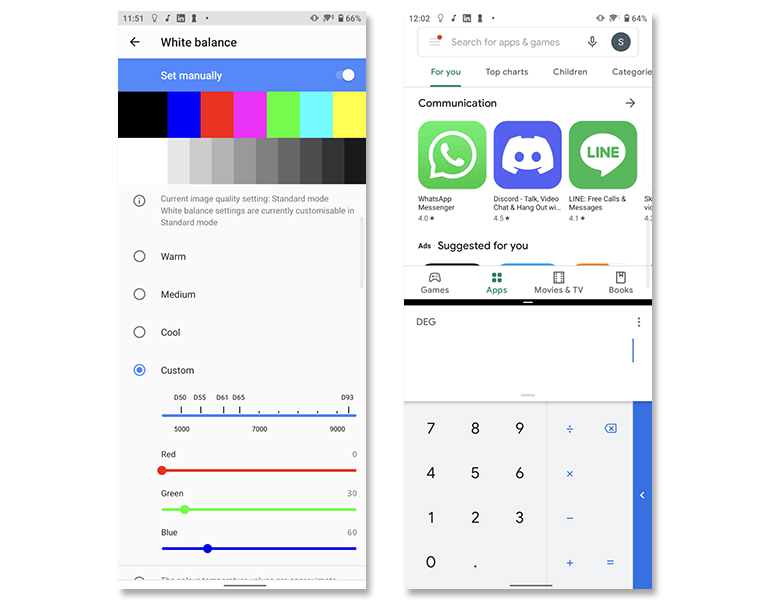
White balance settings (left) and Multi-Window mode (right).
Images: Sandra Vogel / ZDNet
There are controls for the white balance which provide quite a high level of customisation, and games players can also use the Game Enhance settings to adjust many in-game settings, including setting the refresh rate (although doing so is somewhat fiddly).
The speakers also deliver great-quality spoken word output, and have a good bass/treble mix that handles orchestral and chamber music well. On the less positive side (for me, at least), Sony has again implemented its dynamic vibration system, which causes the handset to deliver haptic feedback. I find this irritating, but others may love it. If, like me, you don’t, you can simply disable it.
Sony provides its Side Sense mini-menu system to provide quick access to apps and settings, and to the split-screen mode called Multi-Window. This has its own (rather neat) user interface with pre-designated app pairs and an easy scroll-and-select system for picking apps to view split screen. Side Sense is pretty intuitive, and Multi-Window is also accessible via an app icon on the home screen.
Powered by Qualcomm’s top-end Snapdragon 888 5G chipset with 12GB of RAM, the Xperia 1 III turned in excellent Geekbench 5 benchmarks: 1128 single core and 3629 multi core. The Xiaomi Mi 11 Ultra and Mi 11 both just beat it with single core scores of 1134 and 1129 and multi core scores of 3718 and 3704 respectively, while the Oppo Find X3 Pro 5G was just behind with scores of 927 and 3302. These differences are marginal, though, and all Snapdragon 888 handsets we’ve tested so far perform superbly.
With 256GB of internal storage and 27GB used out of the box, there’s 229GB free for personal use. Sony’s chunk of the out-of-box usage includes its interface tweaks and usability enhancements as well as pre-installed apps such as its own PS app for PlayStation fans.
There are three 12MP cameras at the back plus an 8MP f/2.0 front-facing camera. The main rear camera is a 12MP f/1.7 wide-angle unit with OIS. This is joined by a 12MP f/2.2 ultra-wide-angle (124°) camera and a 12MP adaptive telephoto camera with OIS and dual lenses — f/2.3 70mm and f/.2.8 105mm. The idea is that when you’re doing telephoto shooting the switch between the two lenses is smooth and seamless.
Maximum zoom is 12.5x hybrid, with stops at 2.9x and 4.4x for each of the two telephoto lenses. This might sound complicated, but in practice it’s quick and easy to work with. Just point the camera, and select which of the zoom options you require from the on-screen buttons, and then slide between the presets to adjust as required.
The second excellent feature here is Dual PDAF sensors, which enable fast autofocus, including on moving subjects. I combined the zoom and autofocus capability to great effect, managing to easily grab zoomed-in photos of my cat moving around the lawn. The picture shown here was taken at 4.4x zoom and was a single point-and-shoot image as the cat came towards me to ask for a bit of attention.

Photo taken with the 4.4x zoom setting on the Xperia 1 III’s dual-lens telephoto camera.
Image: Sandra Vogel / ZDNet
The Xperia 1 III’s 4500mAh battery kept it going for 10 hours 27 minutes under the PCMark for Android Work 3.0 battery rundown test. For comparison, all of the top 20 handsets tested with this benchmark lasted for over 15 hours, while the longest-lasting Snapdragon 888-based phone — Xiaomi’s Redmi K40 Pro — managed just over 14 hours. In my tests it dropped 29% from a full charge in a three-hour YouTube streaming session, suggesting battery life of around 10 hours.
Sony says the battery can fast-charge to 50% in 30 minutes. On one occasion with the battery at 20% it got up to 66% in half an hour. Wireless and reverse wireless charging are both supported.
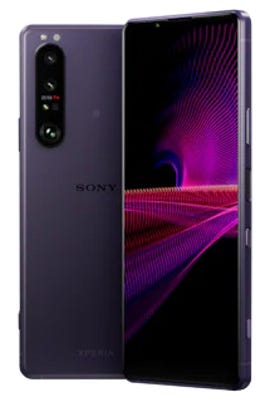
Conclusions
The Xperia I III brings Sony’s flagship handset up to date with a Snapdragon 888 SoC, improved cameras and a 4K OLED screen with a 120Hz refresh rate as headline features. It retains the unusual 21:9 aspect ratio, and delivers good-quality video and excellent audio. There’s a lot to like if you’re into photography, video, gaming or media consumption, and the dual-lens telephoto camera is a usable solution. Battery life could be better, especially if you make heavy use of 4K resolution and the 120Hz refresh rate, but fast charging should keep downtime to a minimum if mains power is accessible.
RECENT AND RELATED CONTENT
Sony Xperia 1 II review: Cinematic 4K screen, 5G and better battery life, but the price is high
Sony Xperia 5 II review: A compact version of Sony’s wide-screen 5G flagship
Sony Xperia 10 II review: An affordable but disappointing wide-screen experience
Best camera phone 2021: Take the best pics and vids
Read more reviews



